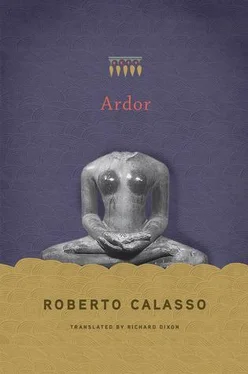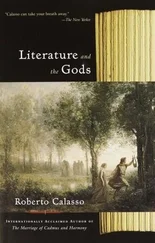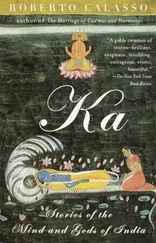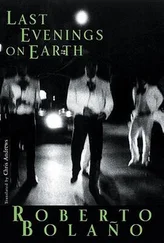The scene has to be observed from the viewpoint of the gods. Before a man (any man) crosses the line of the fires, the gods ignore him. Then, “having walked around the āhavanīya fire, from the east, he passes between it and the gārhapatya fire. For the gods do not know this man; but when he now passes between the fires they know him and think: ‘This is he who is about to make an oblation to us.’” When the ceremony begins, the man must first make himself recognized. The gods, until then, seem not to notice him. His destiny seems unimportant to them, his essence — undefined. They are huddled around the altar, but this is all they know about the earth, and all that interests them. So to make himself noticed, and then recognized, the man passes between the two main fires. That is the line on which tension vibrates, giving meaning. When the gods see someone crossing it, they immediately know something is going on. At that moment the man is recognized and finally exists. And he exists only so far as it is he who will present an offering. Man’s original lack of substance is gone and he becomes a being with whom the gods will deal. This is how relations between men and gods are established.
The sacrificer’s first concern will still be not to act in vain: the oblations are offered, the complex liturgical machinery is set in motion, but the gods can still ignore him. They may not recognize the sacrificer. More than the Hegelian recognition between master and servant, Vedic men were worried about the recognition between gods and sacrificer. Hence the excited dialogue between adhvaryu and agnīdh , his assistant, who is responsible for lighting the fire: “‘Has he gone, agnīdh ?’ and with this he means: ‘Has he really gone?’ ‘He has gone,’ replies the other. ‘Ask that they listen to him.’” The officiants are those who are already familiar with the world of the sky. This is the basis of their existence. What is more, they depend on the ritual fees they receive from the sacrificer, who is, however, an ordinary man, someone whom the gods may even ignore.
The dialogue between the officiants takes place on a barren open space, marked out by three fires. The officiants had to understand whether the rite was successful. But how? By talking about the invisible, about something that was happening — perhaps — between the gods, between them and the sacrificer, along that aerial track which was the sacrifice. At that moment they might have seemed absorbed in monologues, participants in an identical hallucination.
* * *
According to Coomaraswamy, “the oldest Indian type of sacred architecture, both enclosed and roofed,” is the sadas , the hut where the sacrificer or the initiand spends the night before starting the liturgical acts. “A place ‘apart’ ( tiras, antarhita ) to which the gods resort.” A place that helps us to understand the reason for every closed space: for “the gods are segregated from men, and thus secret also is this which is closed on every side.” The sacrificer sleeps there and, so long as he is there, “truly he comes close to the gods and becomes one of the divinities.” But nothing is permanent: soon after the rite, the hut will be demolished. And yet it is in this empty, fragile, and makeshift place, before even the temple came into being, that contact is made with the gods. Emptiness and separation from the rest of the world are enough. The first image of what will one day be the study , not just of St. Jerome, but of every writer: that room which is a witness to writing and protects it with “the cloak of initiation and of ardor.”
* * *
It is a premise of Vedic sacrifice that only while man is preparing and celebrating it can he become something more than human. It doesn’t matter what he does up to the moment when the fire is set up: he will still just be human. So the night before the agnyādheya , the “setting up of the fires,” he doesn’t even have to remain awake: “Until he has set up a fire of his own, he is simply a man; so he can also sleep, if he so wishes.” Certainly, as it says a little earlier, “the gods are awake”—and coming close to the gods implies participation in their vigil. But it would be pointless of him to do so unless he has his own fire, unless he enters into that opus which is the sacrifice. Wakefulness is the pivotal point of the Vedic world. But it operates only within the uninterrupted work that begins when he sets up his own fire. In any event, Vedic men knew that every evil sprang from a troubled state of mind. They wanted their enemies or rivals to be afflicted by “bad dreams” before every other infirmity (which they listed: “lack of offspring, homelessness, ruin”).
* * *
The premise for every sacrificial act is metaphysical: entering the rite means entering the truth, leaving the rite means returning to untruth. A categorical statement, which ought to be placed beside the enunciation of the Way of Truth in Parmenides’ poem. The ritualist’s style is spare, abrupt, abrasive. There is no gradual progression and there are no moments of relief. The words are all the more penetrating: “Twofold is this, there is no third: truth and untruth. And the gods are truth, men are untruth. And so, by saying: ‘I now enter from untruth into truth,’ he [the sacrificer] passes from men to the gods. He shall speak only what is true. For the gods keep this vow: to speak the truth. And for this they are splendid. Splendid then is he who, knowing this, speaks the truth.”
There are two extremities of existence, two poles between which tension flows: truth and untruth. Like being and nonbeing in Parmenides. Tertium non datur. And the space in which this occurs has the sky and the earth as its extremities — or the āhavanīya fire and the gārhapatya fire. But we immediately notice a peculiarity: “truth” and “untruth,” in the text, are satya and anṛta. As if anṛta was the negation of another truth, indicated by the word ṛta. This takes us back to another open question: Heinrich Lüders, in his monumental, unfinished Varuṇa , devoted page after page to showing that ṛta , often translated as “order,” primarily meant “truth.” And his theory would seem to be borne out by the above passage, where satya and ṛta appear as equivalents. But synonyms do not exist. Satya is truth in relation to “that which is,” sat. Ṛta contains within it a reference to order, to the correct articulation which is in the root ar- (from which the Latin ars, artus— and also ritus ). In ṛta the truth is still visibly linked to an arrangement of forms, to a certain way in which they are connected.
It is the liturgy of the agnihotra— the morning and evening libations, the germ cell of all sacrifices — that sheds light on the relationship between satya and ṛta. In a passage in the Maitrāyaṇī Saṃhitā we read: “The agnihotra is ṛta and satya. ” Bodewitz translates this as “order and truth” and notes: “This of one of the passages which show that ṛta , ‘order,’ here occurring together with satya , ‘truth,’ does not mean ‘truth,’ as Lüders assumes in Varuṇa II.” And so a vast body of investigation would seem to come to nothing in just a few short words. But does it really come to nothing? Or are both scholars perhaps right in a certain way —and is our conception of the word truth too limited? Let us now consider another passage in the liturgy of the agnihotra : before moving on to the oblation, the adhvaryu touches the water and says: “You are the thunderbolt; take my evil from me. From sacred order ( ṛta ) I enter the truth ( satya ).” That is how P. E. Dumont translates it. But according to Willem Caland: “From the just I pass to the true.” Ṛta and satya , the Vedic ritualists would say, are a couple (like, as we will see elsewhere, satya and śraddhā , “trust in the efficacy of ritual”) and their relationship is dynamic: from almost a superimposition we pass to a contraposition. Truth, in ṛta , is interlinked with order, above all with the order of the world watched over by Varuṇa. And in this sense the word, having fallen into disuse after the Vedic era, would be replaced by dharma , where the meaning of “order” is clothed by that of “law” (we are at the origin of law and order ). In satya , on the other hand, truth is a simple statement of that which is , devoid of any other reference. And so from order ( ṛta ) we can arrive at truth ( satya ), as from one degree of the same truth to another, now entirely free of any cosmic reference.
Читать дальше












